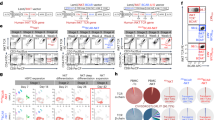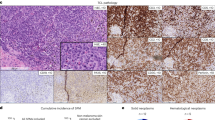Abstract
Analysis of minimal residual disease (MRD) in childhood acute myeloid leukemia (AML) may predict for clinical outcome. MRD levels were assessed by flowcytometric immunophenotyping in 94 children with AML enrolled into a single trial (United Kingdom Medical Research Council AML12 and similar Dutch Childhood Oncology Group ANLL97). An aberrant immunophenotype could be detected in 94% of patients. MRD levels after the first course of chemotherapy predicted for clinical outcome: 3-year relapse-free survival was 85%±8% (s.e.) for MRD-negative patients (MRD<0.1%), 64%±10% for MRD-low-positive patients (0.1%⩽MRD<0.5%) and only 14±9% for MRD-high-positive patients (MRD⩾0.5%; P<0.001), whereas overall survival was 95%±5%, 70%±10% and 40%±13%, respectively, (P<0.001). Multivariate analysis allowing for age, karyotype, FLT3-internal tandem duplications and white blood cell count at diagnosis showed that MRD after the first course of chemotherapy was an independent prognostic factor. Although comparison of paired diagnosis-relapse samples (n=23) showed immunophenotypic shifts in 91% of cases, this did not hamper MRD analysis. In conclusion, flowcytometric MRD detection is possible in children with AML. The level of MRD after the first course of chemotherapy provides prognostic information that may be used to guide therapy.
This is a preview of subscription content, access via your institution
Access options
Subscribe to this journal
Receive 12 print issues and online access
$259.00 per year
only $21.58 per issue
Buy this article
- Purchase on Springer Link
- Instant access to full article PDF
Prices may be subject to local taxes which are calculated during checkout




Similar content being viewed by others
References
Coustan-Smith E, Ribeiro RC, Rubnitz JE, Razzouk BI, Pui CH, Pounds S et al. Clinical significance of residual disease during treatment in childhood acute myeloid leukaemia. Br J Haematol 2003; 123: 243–252.
Langebrake C, Creutzig U, Dworzak M, Hrusak O, Mejstrikova E, Griesinger F et al. Residual disease monitoring in childhood acute myeloid leukemia by multiparameter flow cytometry: the MRD-AML-BFM Study Group. J Clin Oncol 2006; 24: 3686–3692.
Sievers EL, Lange BJ, Buckley JD, Smith FO, Wells DA, Daigneault-Creech CA et al. Prediction of relapse of pediatric acute myeloid leukemia by use of multidimensional flow cytometry. J Natl Cancer Inst 1996; 88: 1483–1488.
Sievers EL, Lange BJ, Alonzo TA, Gerbing RB, Bernstein ID, Smith FO et al. Immunophenotypic evidence of leukemia after induction therapy predicts relapse: results from a prospective Children's Cancer Group Study of 252 patients with acute myeloid leukemia. Blood 2003; 101: 3398–3406.
Kern W, Voskova D, Schoch C, Hiddemann W, Schnittger S, Haferlach T . Determination of relapse risk based on assessment of minimal residual disease during complete remission by multiparameter flow cytometry in unselected patients with acute myeloid leukemia. Blood 2004; 104: 3078–3085.
San Miguel JF, Martinez A, Macedo A, Vidriales MB, Lopez-Berges C, Gonzalez M et al. Immunophenotyping investigation of minimal residual disease is a useful approach for predicting relapse in acute myeloid leukemia patients. Blood 1997; 90: 2465–2470.
San Miguel JF, Vidriales MB, Lopez-Berges C, Diaz-Mediavilla J, Gutierrez N, Canizo C et al. Early immunophenotypical evaluation of minimal residual disease in acute myeloid leukemia identifies different patient risk groups and may contribute to postinduction treatment stratification. Blood 2001; 98: 1746–1751.
Venditti A, Buccisano F, Del Poeta G, Maurillo L, Tamburini A, Cox C et al. Level of minimal residual disease after consolidation therapy predicts outcome in acute myeloid leukemia. Blood 2000; 96: 3948–3952.
Venditti A, Tamburini A, Buccisano F, Del Poeta G, Maurillo L, Panetta P et al. Clinical relevance of minimal residual disease detection in adult acute myeloid leukemia. J Hematother Stem Cell Res 2002; 11: 349–357.
Wheatley K, Burnett AK, Goldstone AH, Gray RG, Hann IM, Harrison CJ et al. A simple, robust, validated and highly predictive index for the determination of risk-directed therapy in acute myeloid leukaemia derived from the MRC AML 10 trial. United Kingdom Medical Research Council's Adult and Childhood Leukaemia Working Parties. Br J Haematol 1999; 107: 69–79.
van Lochem EG, van der Velden VH, Wind HK, te Marvelde JG, Westerdaal NA, van Dongen JJ . Immunophenotypic differentiation patterns of normal hematopoiesis in human bone marrow: reference patterns for age-related changes and disease-induced shifts. Cytometry B Clin Cytom 2004; 60: 1–13.
van Dongen JJ, Macintyre EA, Gabert JA, Delabesse E, Rossi V, Saglio G et al. Standardized RT-PCR analysis of fusion gene transcripts from chromosome aberrations in acute leukemia for detection of minimal residual disease. Report of the BIOMED-1 Concerted Action: investigation of minimal residual disease in acute leukemia. Leukemia 1999; 13: 1901–1928.
Boeckx N, Willemse MJ, Szczepanski T, van der Velden VH, Langerak AW, Vandekerckhove P et al. Fusion gene transcripts and Ig/TCR gene rearrangements are complementary but infrequent targets for PCR-based detection of minimal residual disease in acute myeloid leukemia. Leukemia 2002; 16: 368–375.
Kiyoi H, Naoe T, Nakano Y, Yokota S, Minami S, Miyawaki S et al. Prognostic implication of FLT3 and N-RAS gene mutations in acute myeloid leukemia. Blood 1999; 93: 3074–3080.
Reinhardt D, Langebrake C, Creutzig U, Vormoor J, Brune C, Thorwesten M et al. Minimal residual disease in acute myeloid leukemia in children--standardization and evaluation of immunophenotyping in the AML-BFM-98 study. Klin Padiatr 2002; 214: 179–187.
Burnett AK, Wheatley K, Goldstone AH, Gibson B, Webb D, Prentice AG et al. MRC AML12: A comparison of ADE vs MAE and S-DAT vs H-DAT +/- retinoic acid for induction and four vs five total courses using chemotherapy or stem cell transplant in consolidation, in 3459 patients under 60 years with AML. Blood 2002; 100 (abstract 155A).
Feller N, van der Pol MA, van Stijn A, Weijers GW, Westra AH, Evertse BW et al. MRD parameters using immunophenotypic detection methods are highly reliable in predicting survival in acute myeloid leukaemia. Leukemia 2004; 18: 1380–1390.
Buccisano F, Maurillo L, Gattei V, Del Poeta G, Del Principe MI, Cox MC et al. The kinetics of reduction of minimal residual disease impacts on duration of response and survival of patients with acute myeloid leukemia. Leukemia 2006; 20: 1783–1789.
Baer MR, Stewart CC, Dodge RK, Leget G, Sule N, Mrozek K et al. High frequency of immunophenotype changes in acute myeloid leukemia at relapse: implications for residual disease detection (Cancer and Leukemia Group B Study 8361). Blood 2001; 97: 3574–3580.
Langebrake C, Brinkmann I, Teigler-Schlegel A, Creutzig U, Griesinger F, Puhlmann U et al. Immunophenotypic differences between diagnosis and relapse in childhood AML: implications for MRD monitoring. Cytometry B Clin Cytom 2005; 63: 1–9.
Voskova D, Schoch C, Schnittger S, Hiddemann W, Haferlach T, Kern W . Stability of leukemia-associated aberrant immunophenotypes in patients with acute myeloid leukemia between diagnosis and relapse: comparison with cytomorphologic, cytogenetic, and molecular genetic findings. Cytometry B Clin Cytom 2004; 62: 25–38.
van der Velden VH, Jacobs DC, Wijkhuijs AJ, Comans-Bitter WM, Willemse MJ, Hahlen K et al. Minimal residual disease levels in bone marrow and peripheral blood are comparable in children with T cell acute lymphoblastic leukemia (ALL), but not in precursor-B-ALL. Leukemia 2002; 16: 1432–1436.
Boeckx N, De Roover J, van der Velden VH, Maertens J, Uyttebroeck A, Vandenberghe P et al. Quantification of CBFB-MYH11 fusion gene levels in paired peripheral blood and bone marrow samples by real-time PCR. Leukemia 2005; 19: 1988–1990.
Maurillo L, Buccisano F, Spagnoli A, Del Poeta G, Panetta P, Neri B et al. Monitoring of minimal residual disease in adult acute myeloid leukemia using peripheral blood as an alternative source to bone marrow. Haematologica 2007; 92: 605–611.
Leroy H, de Botton S, Grardel-Duflos N, Darre S, Leleu X, Roumier C et al. Prognostic value of real-time quantitative PCR (RQ-PCR) in AML with t(8;21). Leukemia 2005; 19: 367–372.
Elliott MA, Litzow MR, Letendre LL, Wolf RC, Hanson CA, Tefferi A et al. Early peripheral blood blast clearance during induction chemotherapy for acute myeloid leukemia predicts superior relapse-free survival. Blood 2007; 110: 4172–4174.
Goulden N, Virgo P, Grimwade D . Minimal residual disease directed therapy for childhood acute myeloid leukaemia: the time is now. Br J Haematol 2006; 134: 273–282.
Pedreira CE, Costa ES, Barrena S, Lecrevisse Q, Almeida J, van Dongen JJ et al. Generation of flow cytometry data files with a potentially infinite number of dimensions. Cytometry A 2008; 73A: 1141–1150.
van Rhenen A, Moshaver B, Kelder A, Feller N, Nieuwint AW, Zweegman S et al. Aberrant marker expression patterns on the CD34+CD38− stem cell compartment in acute myeloid leukemia allows to distinguish the malignant from the normal stem cell compartment both at diagnosis and in remission. Leukemia 2007; 21: 1700–1707.
van Rhenen A, van Dongen GA, Kelder A, Rombouts EJ, Feller N, Moshaver B et al. The novel AML stem cell associated antigen CLL-1 aids in discrimination between normal and leukemic stem cells. Blood 2007; 110: 2659–2666.
Acknowledgements
We acknowledge the Leukaemia Research Fund for financial support of sample transportation (grant LRF-0041). We thank all clinicians participating in this study for providing patient material and clinical data. Members of the DCOG ANLL97 protocol committee were Siebold SN de Graaf (Chairman), Henk van den Berg, Marc Bierings, Anne van der Does-van den Berg, Gaby Kardos and Margreet van Weel-Sipman (deceased). Members of the MRC AML12 protocol committee were Brenda ES Gibson (Chairman), David Webb, Alan K Burnett, Keith Wheatley and Christine Harrison. We thank the members of the Dutch Working Party on MRD analysis in AML (R Brooimans, F Preijers, N Boeckx, A Kelder, J Slomp) for their support in evaluating the sensitivities of the LAIPs.
Author information
Authors and Affiliations
Corresponding author
Ethics declarations
Competing interests
The authors declare no conflict of interest.
Additional information
Supplementary Information accompanies the paper on the Leukemia website
Supplementary information
Rights and permissions
About this article
Cite this article
van der Velden, V., van der Sluijs-Geling, A., Gibson, B. et al. Clinical significance of flowcytometric minimal residual disease detection in pediatric acute myeloid leukemia patients treated according to the DCOG ANLL97/MRC AML12 protocol. Leukemia 24, 1599–1606 (2010). https://doi.org/10.1038/leu.2010.153
Received:
Revised:
Accepted:
Published:
Issue Date:
DOI: https://doi.org/10.1038/leu.2010.153
Keywords
This article is cited by
-
Prognostic significance of multiparametric flow cytometry minimal residual disease at two time points after induction in pediatric acute myeloid leukemia
BMC Cancer (2024)
-
Genomic DNA-based measurable residual disease monitoring in pediatric acute myeloid leukemia: unselected consecutive cohort study
Leukemia (2024)
-
Association of hematologic response and assay sensitivity on the prognostic impact of measurable residual disease in acute myeloid leukemia: a systematic review and meta-analysis
Leukemia (2022)
-
Measurable residual disease status and outcome of transplant in acute myeloid leukemia in second complete remission: a study by the acute leukemia working party of the EBMT
Blood Cancer Journal (2021)
-
Impact of measurable residual disease by decentralized flow cytometry: a PETHEMA real-world study in 1076 patients with acute myeloid leukemia
Leukemia (2021)



